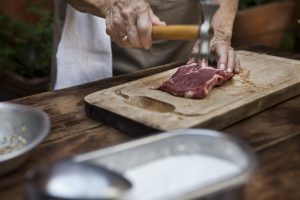 Our bodies need protein for many functions, but the older we get the more we need. Unfortunately, many seniors are not getting adequate protein, so they suffer from muscle loss and weakness, which can increase their risk of injury and disability.
Our bodies need protein for many functions, but the older we get the more we need. Unfortunately, many seniors are not getting adequate protein, so they suffer from muscle loss and weakness, which can increase their risk of injury and disability.
When you were younger, you probably felt as strong as a bull. But now that you’re older, sometimes even the smallest objects feel like 100-pound weights. Maintaining muscle mass in your senior years is important as it helps keep the body stable, reducing the risk of falls that may lead to crippling disability, isolation, and even depression. So if you’re concerned about your muscles, bulk up on protein.
Seniors need more protein for strong muscles and strength
Advertisement
The study found that seniors require protein from animal sources along with plant sources, as different types of protein play different roles in muscle mass. Plant protein helps preserve muscle strength, while animal protein helps with muscle mass.
Lead researcher Shivani Sahni said, “With aging, there is loss of muscle mass and strength. After 50, people start to lose muscle mass. Between 50 and 60, muscle strength declines by about 1.5 percent a year. After 60, the loss can be three percent a year.”
The loss of muscle mass and strength negatively impacts a person’s ability to perform daily tasks and to move around. Loss of muscle mass can also increase the risk of falls as it impacts the balance. Sahni added, “Overall protein intake is important for maintaining muscle mass and muscle strength. You should have protein as part of every meal.”
The study collected data from over 2,600 men and women who took part in the Framingham Offspring Cohort study. The average age of participants was 60. The researchers measured their protein intake, leg lean mass, and muscle strength.
The researchers found that men required three ounces of protein a day to maintain muscle mass and strength, while women required 2.6 ounces. Although plant protein was not associated with lean mass, those who consumed the highest amounts had greater strength in their thigh muscles, compared to those with the minimal intake.
Samantha Heller, a senior clinical nutritionist at New York University Medical Center, not involved in the study, commented, “Many large studies suggest that those who eat diets high in animal foods have an increased rate of death and risk of diseases such as cancer, heart disease, and diabetes, while plant-based diets reduce the risks of dying and chronic diseases.”
“Research suggests that we may need more protein as we age,” she said. There are many reasons why older adults may consume too little protein, from being less active or less hungry to poor dental health, lower income, or limited access to food,” she added.
Protein should be spread throughout the day across all meals, as opposed to bulking up in one meal. Heller recommended the following protein sources: six ounces plain non-fat Greek yogurt (0.6 ounces of protein), eight ounces fat-free milk (0.2 ounces protein), one-half cup cooked beans (nearly 0.3 ounces), and two tablespoons of nut butter (0.2 ounces). A 3.5-ounce portion of roasted chicken breast provides almost two ounces of protein, five ounces of tofu deliver 0.4 ounces of protein, and two slices of whole wheat bread provide 0.2 ounces of protein.
“A peanut butter and jelly sandwich on whole wheat bread with a glass of milk would contain just under an ounce of protein,” Heller said.
Although protein is beneficial for muscle mass and strength, incorporating exercise is equally important to help further build that muscle mass and strength rather than just preserving them. Even if you eat a ton of protein, if you’re not building the muscle there isn’t much to hold on to. Therefore, a healthy combination of protein and exercise is needed to maintain good health.
Related Reading:
Longer rests between sets increase muscle growth
If you’re looking to build greater muscle mass, taking longer rests in-between your weight-lifting sets may be the trick. It has been long believed that shorter breaks between sets could promote muscle growth, but in fact this hinders it and damages the muscles. Continue reading…
Advertisement
Building muscle reduces heart disease mortality
Building muscle helps reduce the risk of early death from heart disease, so doctors should encourage their patients to partake in resistance and strength training as part of a healthy lifestyle. The researchers analyzed data from over 6,400 Americans with heart disease. Continue reading…
Source:
http://news.health.com/2015/06/10/older-americans-need-protein-to-keep-muscles-strong-study-says/
